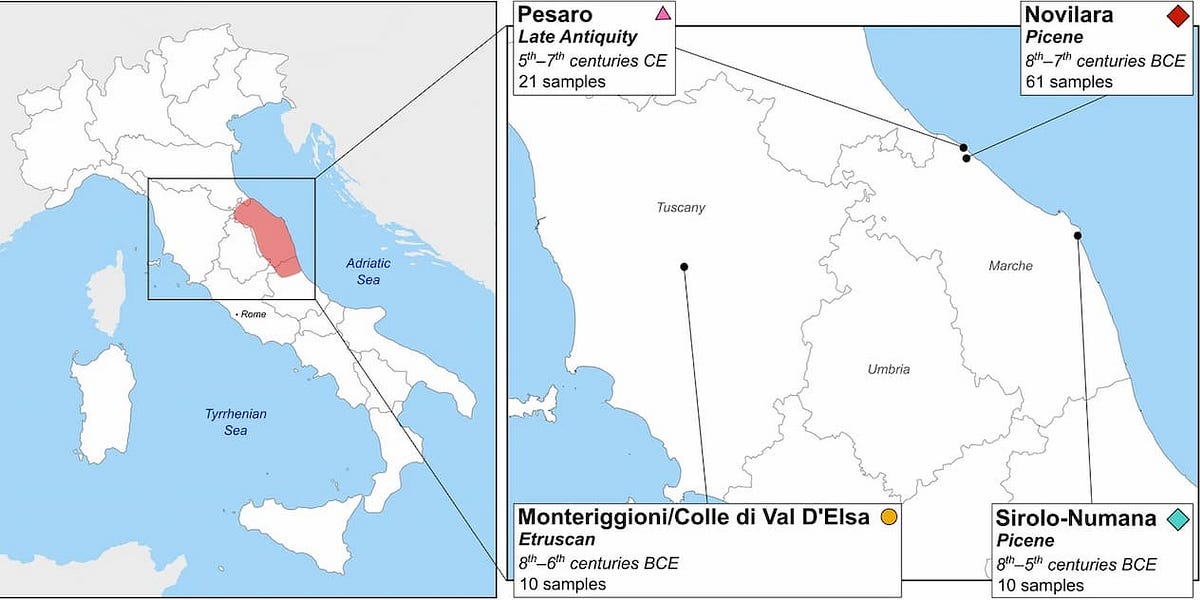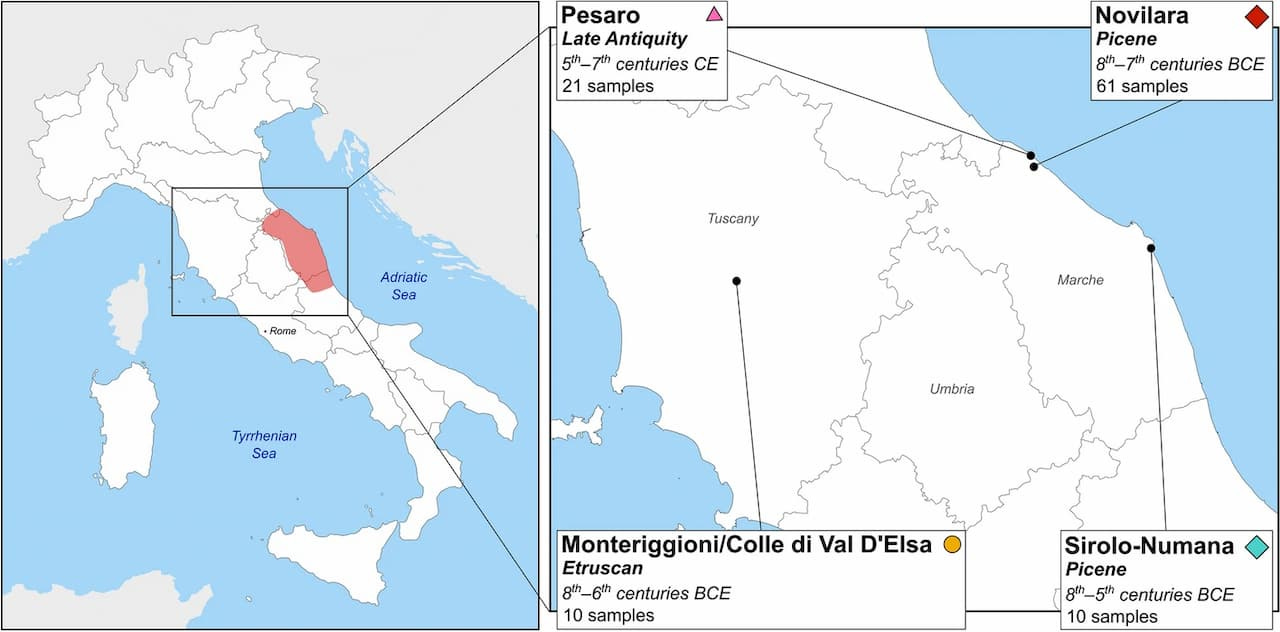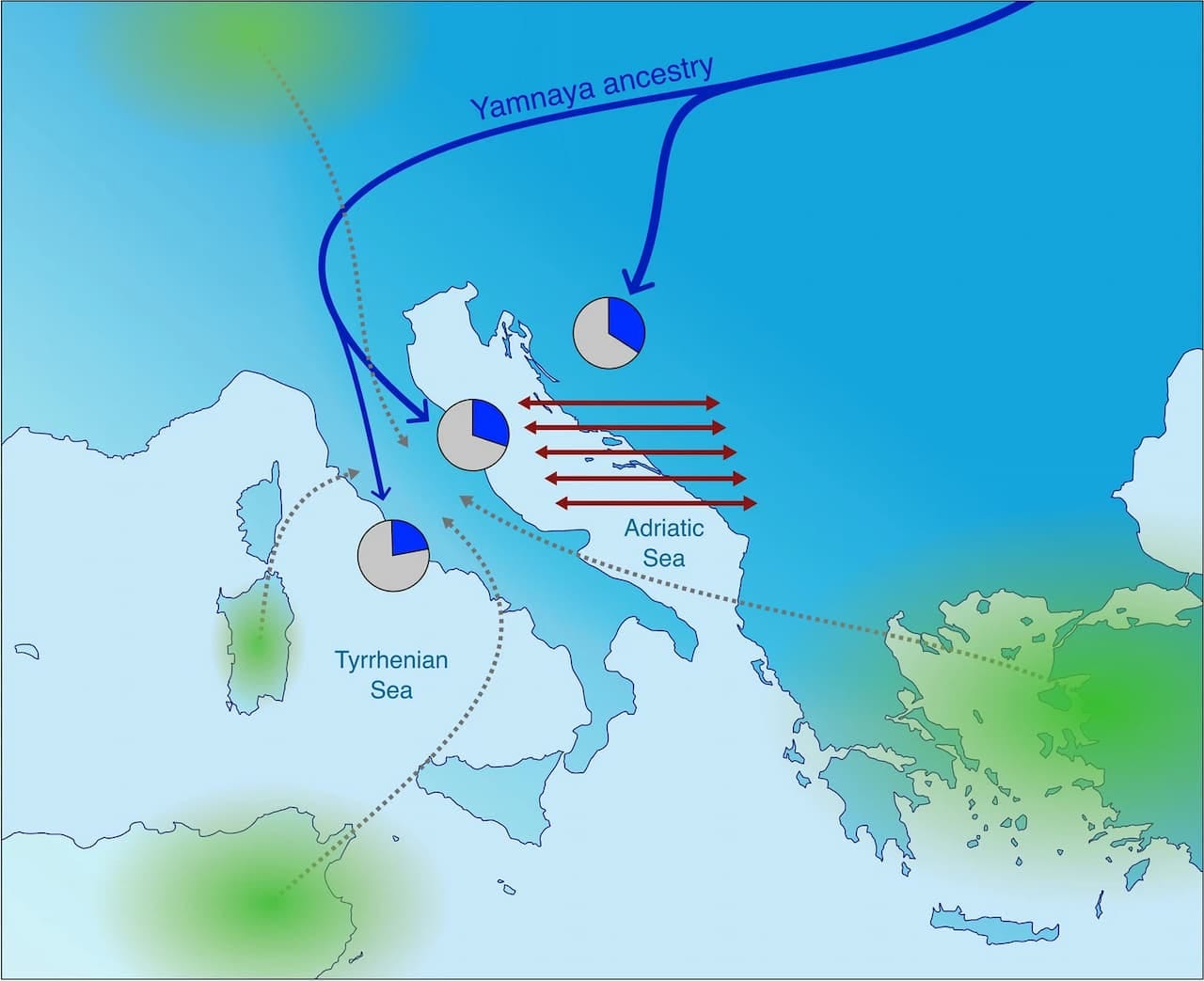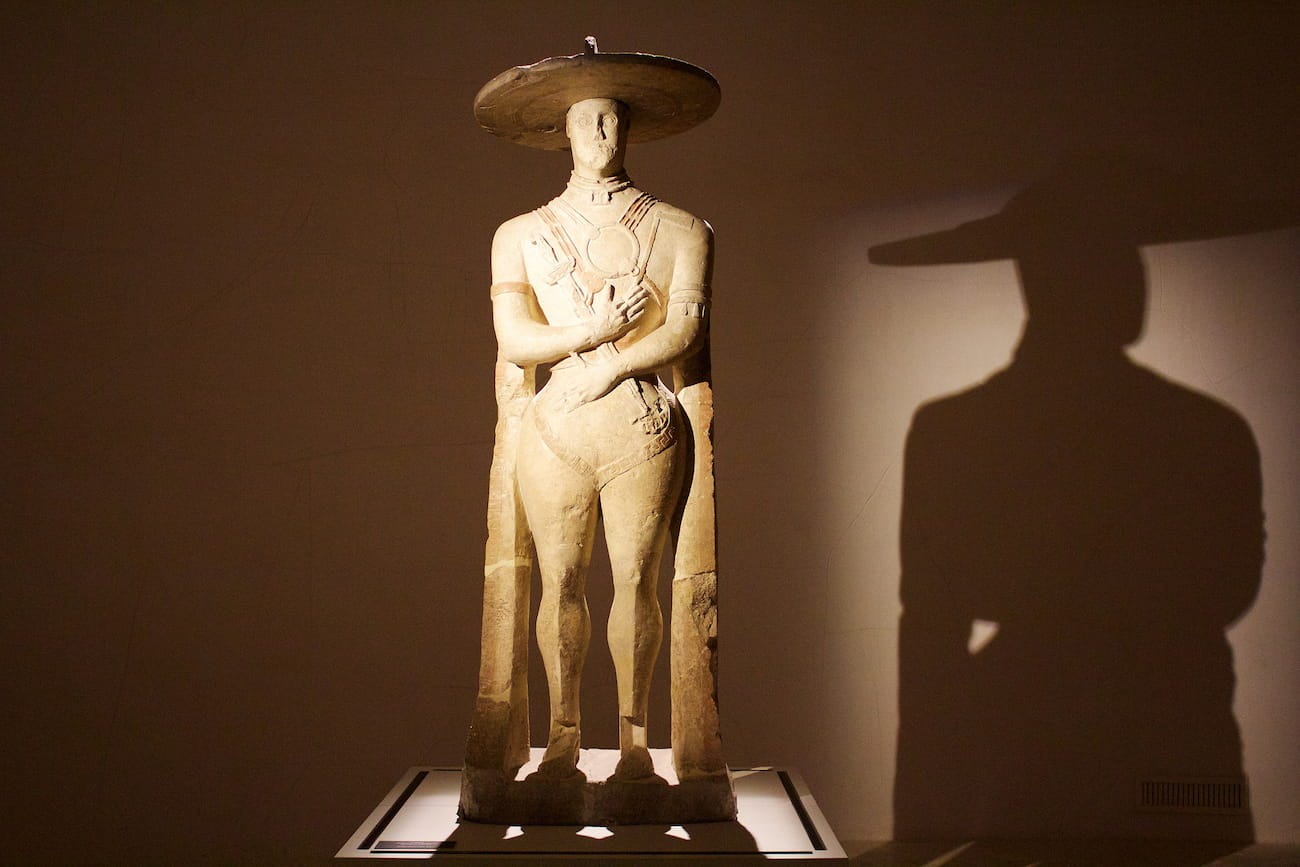
The Italian Peninsula before the rise of Rome was a tapestry of diverse ethnic groups, each with unique languages, customs, and material cultures. Among them, the Picenes, who thrived along the Middle Adriatic coast from the 9th to 3rd centuries BCE, have remained an enigmatic presence in the historical record. A recent study, The Genomic Portrait of the Picene Culture, published in Genome Biology, attempts to decode their past through ancient DNA analysis. This research not only illuminates the genetic identity of the Picenes but also provides valuable insights into the broader demographic shifts that shaped Central Italy before and after the Roman conquest.
Unlike their more famous contemporaries, such as the Etruscans and Latins, the Picenes left behind few written records. Our understanding of them has primarily come from archaeology—richly adorned graves, weapons, and evidence of trade. However, this new genomic study, led by Francesco Ravasini and colleagues, reconstructs the biological history of the Picenes using DNA extracted from 102 ancient individuals spanning over 1,000 years of history.

By sequencing and analyzing these remains, the researchers uncovered a surprising genetic homogeneity among Picene populations, despite their distinct cultural markers. They also found subtle but significant differences between the Picenes and other Central Italian groups, suggesting that populations along the Adriatic and Tyrrhenian coasts evolved along slightly divergent genetic trajectories.
One of the study’s most compelling findings is the evidence of long-standing genetic exchanges between the Picenes and populations across the Adriatic Sea. This trans-Adriatic connection aligns with archaeological evidence of extensive trade between Italy and the Balkans, where goods and cultural influences flowed freely in both directions. The genetic signatures of some individuals suggest admixture with populations from Northern Europe and the Near East, likely due to migration and commerce.
“Our findings, consistent with archaeological hypotheses, suggest genetic interactions across the Adriatic Sea during the Bronze and Iron Ages, with a high level of individual mobility characteristic of cosmopolitan societies.”
Despite these external influences, the Picenes largely retained a genetic profile similar to other Iron Age Italic groups, emphasizing a shared ancestry that predated the Roman era. However, their genetic makeup shows a higher proportion of Yamnaya (Steppe) ancestry compared to their neighbors on the Tyrrhenian side, a remnant of earlier migration waves that swept into Europe during the Bronze Age.
The Roman conquest of the Picene territories in the 3rd century BCE marked a turning point in their history. The study highlights how, over the centuries, the genetic landscape of the region transformed, with an increasing influx of Near Eastern ancestry. This shift mirrors broader patterns across the Roman Empire, where the movement of people—soldiers, merchants, and slaves—led to significant genetic mixing.

A particularly striking finding comes from the Late Antiquity site of Pesaro, where researchers observed a drastic genetic shift. Individuals from this period exhibit a strong genetic pull toward the Near East, reflecting the demographic changes brought about by Rome’s vast Mediterranean network.
“The rise of the multicultural Roman Empire changed the genetic landscape of Central Italy, introducing a strong genetic component from the Near East that persisted throughout Late Antiquity.”
This suggests that the genetic transformation of Italy was not a sudden event but rather a gradual process driven by centuries of Roman expansion and integration.
Beyond their genetic identity, the study also offers fascinating glimpses into the physical traits of the Picenes. Their DNA reveals a higher prevalence of lighter pigmentation—blond hair and blue eyes—compared to the Etruscans and Latins. These traits, while not dominant, hint at an ancestral connection to populations further north.
At the same time, evidence of disease-related genetic markers suggests that the Picenes, like other Iron Age populations, faced significant health challenges. Some individuals carried alleles linked to Crohn’s disease and gluten intolerance, conditions that may have been influenced by dietary shifts over millennia.
The genetic diversity within Picene communities, coupled with the presence of outlier individuals from distant regions, underscores the mobility and fluidity of ancient Mediterranean societies. The Picenes were not an isolated group but active participants in the complex web of interactions that shaped pre-Roman Italy.
The genomic analysis of the Picenes represents a major step forward in our understanding of Italy’s Iron Age cultures. While the Picenes eventually faded from history, absorbed into the expanding Roman state, their genetic legacy persisted. This study reinforces the idea that ancient Italy was already a melting pot long before the Roman Empire reached its zenith.
By combining genetics with archaeology, researchers are painting a more detailed picture of how past populations lived, migrated, and adapted to changing landscapes. As ancient DNA studies continue to refine our knowledge of early civilizations, we may yet uncover more forgotten histories hidden in the genomes of those who came before us.
-
Antonio, M. L., et al. (2019). Ancient Rome: A genetic crossroads of Europe and the Mediterranean. Science, 366(6466), 708-714. DOI: 10.1126/science.aay6826
-
This study analyzes ancient DNA from Roman-era populations, showing how the genetic landscape of Italy changed due to extensive migration and cultural interactions. It provides critical context for understanding how the Picenes were eventually absorbed into the broader genetic pool of the Roman Empire.
-
-
Posth, C., et al. (2021). The origin and legacy of the Etruscans through a 2000-year genomic time transect. Science Advances, 7(41), eabi7673. DOI: 10.1126/sciadv.abi7673
-
This research traces the genetic continuity of the Etruscans, another enigmatic pre-Roman civilization, showing their genetic stability despite cultural and political shifts. Comparing their genetic patterns with those of the Picenes highlights regional differences in Central Italy’s Iron Age populations.
-
-
Marcus, J. H., et al. (2020). Genetic history from the Middle Neolithic to present on the Mediterranean island of Sardinia. Nature Communications, 11(1), 939. DOI: 10.1038/s41467-020-14523-6
-
A detailed analysis of Sardinian genetic history, revealing the island’s relative isolation despite external influences. This study is useful for comparison with the Picenes, as both regions interacted with Mediterranean trade networks but showed varying degrees of genetic influx.
-
-
Fernandes, D. M., et al. (2020). The spread of Steppe and Iranian-related ancestry in the islands of the western Mediterranean. Nature Ecology & Evolution, 4(3), 334-345. DOI: 10.1038/s41559-020-1102-0
-
Haak, W., et al. (2015). Massive migration from the steppe was a source for Indo-European languages in Europe. Nature, 522(7555), 207-211. DOI: 10.1038/nature14317
-
A foundational study on the spread of Steppe ancestry into Europe, influencing the genetic makeup of later Iron Age populations, including the Picenes. This work provides an essential backdrop for understanding how these migrations shaped early Italic groups.
-
These studies provide crucial context for the genetic findings on the Picenes, illustrating broader patterns of migration, trade, and cultural integration in pre-Roman Italy and the Mediterranean.








